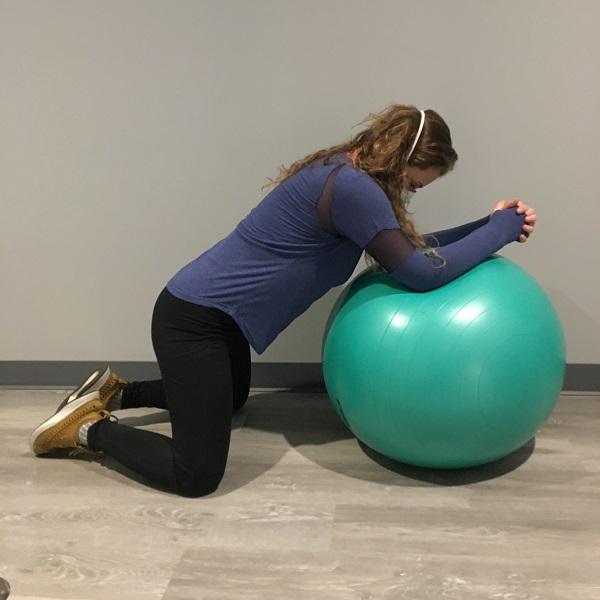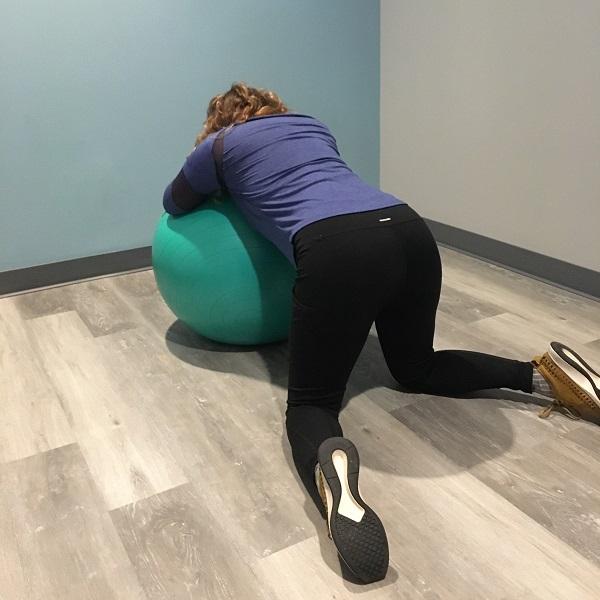
Upright Labor Positions for the Second Stage of Labor
If you missed part 1 in the vaginal childbirth positioning series, go back and read it here.
Childbirth/labor is quite an experience, and it can be scary waiting for the unknown. Being prepared, knowing, and being familiar with different options and labor positions is the best way to approach childbirth to help decrease as much anxiety should surprises arise.
This article will go over specific labor positions that help progress labor, and prevent perineal trauma.
As mentioned in Part 1: Pre-Birth article, it’s important to keep changing labor positions to help progress, preferably in different upright labor positions. As a reminder, the first stage is all about increasing the pelvic inlet to help guide the baby through the mid pelvis and finally towards the pelvic outlet/vaginal canal.

Early labor positions to help baby progress through inlet of pelvis:
- Standing and leaning forward onto a partner, furniture, etc.
- Knees on floor, arms over swiss ball leaning forward onto the ball
- Hands and knees- knees angled away from each other
- Walking, slow dancing
- Sitting on swiss ball and performing gentle posterior pelvic tilts (think tucking tailbone under)
Mid labor positions to help baby move through midpelvis:
- Stair walking
- Side lunges
- standing, hands and knees or kneeling positions with thighs rotated towards each other
It is no longer recommended to be lying flat on your back for a few reasons. We want to allow the sacrum to move freely, as the coccyx (or tailbone) naturally extends backwards to allow for the baby to come through the vaginal canal. The dimensions of our pelvic outlet increases in upright labor positions, specifically in squatting, kneeling or in the hands and knees positions. Gravity works against us when we are lying on our backs, sometimes making it harder for labor to progress.
Benefits of Upright Labor Positions
There are many benefits to upright positioning during labor, such as decreased likelihood of sustaining episiotomies, decreased use of forceps or vacuum assisted births, and decreased instances of fetal distress. However there is an increased risk of second degree tearing and possibly extra blood loss (although there are mixed results). While there is an increased chance of second degree tears, natural tearing is known to heal more effectively than episiotomies.
There is no one position that is best for everyone and having many options is best.
There is a passive second stage (when there is no urge to bear down), and an active second stage of labor (when you feel the urge to bear down/during uterine contractions). If you have difficulty feeling that instinctual urge to bear down, because of an epidural for example, have the nurse or midwife help let you know when the contractions are occurring. When you have breaks in between the contractions, you may want to try to changing to more upright labor positions. Try and practice these 5 labor positions to see how you and your pelvic floor feel.

Stage 2 upright labor positions:
- Hands and knees: Heels are away from each other and toes directed inwards. This labor position is a great way to ease low back pain and expands the pelvic outlet, especially if you tilt your pelvis anteriorly (think “cat” pose or arching of your lower spine). You can put your arms on the birthing ball or at the head of the bed. With the support of your team and adequate muscle strength, it is possible to get into this position with an epidural.
- Lying on your side: Try this with a peanut ball in between legs, or supported by your partner. This is a great labor position for when you need a break in between contractions but still opening up that pelvis and allowing coccyx to move freely. This is also what many people with epidural prefer.
- Half kneeling: This can be done with a birthing ball, rail and/or supported by a partner, etc. Gravity is a plus in this position and helps open up the pelvis. If you suffer from pubic symphysis pain, this is not an ideal labor position for you.
- Squatting: There are many versions of squatting with and without tools. You can bring your body over the birthing ball or put your hands around your partner’s neck or chair, and or on a birthing rail. Gravity is helping, but this labor position does carry an increased risk of tearing. It is recommended to start training in this position to improve flexibility and learn how to relax the pelvic floor in this position. Practice putting your feet in different positions (toes outwards, toes neutral and toes inwards) and in different pelvic positions (tucked under, or leaning forwards/arched).
- Sitting/birthing chair/toilet: Women often feel perineal relief in this position, but sometimes experience some irritation from the toilet seat. This can be another good labor position for those with epidurals. However, this position can sometimes increase blood loss and it is not an ideal position for those with high blood pressure.

If having an epidural, it is possible to get into a squatting or hands and knees position with arms holding onto something strong and sturdy. But it does depend on the strength stability of your legs and your support/birth team to ensure it is done safely.
See a pelvic floor physical therapist to help you go over upright labor positions that make the most sense for you, and start practicing! Check out next week’s blog on the 3rd Stage of Labor.

References:
1. Abdelhaim AM, Eldesouky E, Elmagd IA, et al. Antenatal perineal massage benefits in reducing perineal trauma and postpartum morbidities: a systematic review and meta-analysis of randomized controlled trials. Intl Urogynecol J 31, 1735-1745 (2020). https://doi.org/10.1007/s00192-020-04302-8
2. Ananda, Kara. Better Birthing Through Alignment: Optimal Labor Positioning. https://wellnessblessing.com/blog/2014/3/29/better-birthing-through-alignment-optimal-labor-positioning
3. Dekker, Rebecca. The Evidence on: Birthing Positions. Evidence Based Birth. February 2, 2018. https://evidencebasedbirth.com/evidence-birthing-positions/
4. Hofmeyr GJ, Singata-Madliki M. The second stage of labor. Best Practice & Research Clinical Obstetrics and Gynaecology: 2020, 67; 53-64. https://doi.org/10.1016/j.bpobgyn.2020.03.012
5. Tully, Gail. Three Levels of the Pelvis. Spinning babies. March 7, 2016. https://www.spinningbabies.com/optimal-maternal-postions-at-the-levels-of-the-pelvis/

